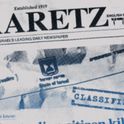Peace demonstrations are tedious events. The speakers say trivial things, the audience applauds at the right moments, somebody sings a song, another releases some white doves, a third reads a poem. Only platitudes and slogans are spoken. The thrill, if there is one, comes from seeing people you love and from confronting those who regard you as an object of hatred. But this particular demonstration seemed relaxed, well-organised and over-protected. The numerous policemen surrounding us were there not to oppose us, but to keep order.
We, two veterans of the peace movement with two teenage children, spent most of the demonstration strolling around, hugging old friends, expressing amazement that our children, born together with the Israeli peace movement, were now teenagers.
We missed most of the speeches. We had been busy telling these children how extraordinary it was for us to find ourselves supporting the government-we who had always been against the establishment. We had not changed our views, the government had. On the platform the Israeli political and cultural establishment was about to vow its commitment to peace, compromise with the Palestinians and non-violence.
But when Miri Aloni began to sing the "Song of Peace" we stopped to listen. She had sung this song at all our peace demonstrations for 17 years. But this time she had Yitzhak Rabin to her left and Shimon Peres to her right. Standing on the stage, dignified and smiling, holding sheets of paper on which the words of the song were written, was the strangest coalition which ever sang this song.
Even our children, who had demonstrated along with us since the day they could walk-or perhaps even before that-could not recall the history of this song. The "Song of Peace" was written after the 1967 war, at the height of Israeli celebrations of the sweeping victory, the "liberation"-to use the official terminology-of the West Bank and Jerusalem. The song was then seen as subversive. Written from the point of view of the fallen, it isn't a song of heroism, it doesn't glorify death or promise resurrection. It describes death as a bitter, unrewarding state which neither the purest of prayers nor the exhilaration of songs of victory can ever reverse.
The message of the fallen is disquieting: "Don't look back, let us rest in peace. Look forward, not through gun sights, but with hope. Don't say the day of peace will come. Set out to bring it about, as it isn't a dream." In the 1960s the song was banned by the Israeli public broadcasting authorities. It was against the spirit of the age. It echoed neither the Bible nor the founders' words, it didn't mention Jerusalem or the Wailing Wall, but made clear reference to the Beatles, Hair, and anti-Vietnam war demonstrations. Like the peace movement itself, the "Song of Peace" slowly made its way to the political centre stage. Like us, it has matured and mellowed. Some of the people who disapproved of it in the 1960s and 1970s-including Yitzhak Rabin himself-were now on stage singing it. "Look," we said to the children, "inscribe this moment in your hearts and minds. Israel is a new state today." A wave of warmth and excitement swept the square. People sang, held hands, and wept. Children danced, clapped their hands and cheered. The sea of banners moved to the rhythm of the music, thousands of balloons filled the sky and calls of jubilation filled the air. On the stage Rabin waved his hand and hugged Peres. They stood, a mirror image of each other, the siamese peace twins of Israel. Together they were unbeatable.
This was the climax. The demonstration was supposed to come to an end. But Rabin insisted that Aviv Gephen, a young Israeli rock star, should have the last word. Aviv Gephen is a combination of Prince and Jane Fonda in her anti-Vietnam war days. He refused to serve in the army, dresses in provocative outfits, and wears earrings and make-up. Not Rabin's cup of tea. But Rabin insisted that if it was promised that Aviv should sing, then he should sing. Aviv sang one of his most beautiful songs, perhaps his most Israeli song-a song of lamentation. "Forever, my friend, we will remember you and in the end we will meet... I have other friends, but your glow overshadows them... be strong up there, we will remember you forever." Rabin was moved and exhilarated. He beamed, hugged Aviv, folded in four the sheet of paper on which the words of the "Song of Peace" were written, placed it in his pocket and stepped down to his death. There were three shots. His blood oozed through the paper and clouded the words of the "Song of Peace." Time froze. The people in the square trembled. Silence spread over the land.
The event was surreal: Magritte or Dali could have painted it; Polanski or Fellini could have staged it; Kundera could have written it. If a script writer had dared to invent such a scene we would have said that he had overdone it; too much symbolism, too many metaphors, too explicit a plot, too many emotional acts-pure kitsch. But history, unlike literary criticism, embraces simplistic symbolism and kitsch: it takes liberties which no author could possibly take.
Rabin's life, like his death, was overdramatic. Leaping from peak to peak, he studied in the elite schools of the Labour movement. When he received the Nobel Peace Prize, he told the audience that at the age of 16, an age fitted for first loves, he learned to use a pistol. When he was 18 he joined the Palmach, the pre-state military force. He soon became the head of operations, then the commander of the Harel brigade, renowned for its legendary battle over the road to Jerusalem. His coffin was driven along that same road 47 years later.
Rabin was chief of staff during Israel's most glorious war in 1967. The next peak came when two decades later, the man who had been in charge of containing the intifada realised that as Israelis we were destined to share our land with the Palestinians. He began the process of withdrawal from the occupied territories which he himself had conquered in 1967.
One peak was to succeed another: the handshake with Arafat; the peace treaty with Jordan; the world wide acclaim. But Rabin aspired to more, he yearned to be loved by his own people. That night at the square he was swamped with love. He accepted all our affection, and shared it with Peres. Their hug was the ultimate moment of reconciliation-every screen-writer knows that this is where the story should end. The camera should zoom out and the picture should slowly fade, just before the light is turned on. But there was to be a final peak-one too many.
If that evening in the square forged a special link between Rabin and many of his people; the funeral cemented his position as a world leader. The picture of King Hussein standing at Mount Herzel, the Jerusalem wind toying with his red-white keffiah, lamenting for Rabin in the presence of President Mubarak of Egypt and the representatives of Qatar and Oman, was even more surreal than that evening in the square. If the new middle east-the one Peres and Rabin dreamed of-had a moment of birth, it was not in Washington, Madrid or Oman, but in Jerusalem, at the moment when King Hussein wept for Rabin.
In his speech at the White House on the occasion of the signing of the agreement with the Palestinians, Rabin quoted Ecclesiastes: "To everything there is a season, and a time to every purpose under the heaven: a time to love, and a time to hate; a time of war, and a time of peace."
Rabin himself was a man for all seasons, a soldier and a peacemaker, a Palmachnik and a skilled diplomat. In his death a part of each of us died. But maybe a new middle east was born in which Israel will be an equal and more modest partner.
What the assassination and the funeral has now made clear to us Israelis is that we can no longer claim that we extend our hand in peace while the Arab world turns its back on us; that we are the only regime in the middle east in which political leaders are immune to assassinations; that the Arab world faces religious fundamentalism and therefore its commitment to peace cannot be trusted, while in Israel, peace enjoys the support of a wall-to-wall coalition. It is now clear that we all share the same problems, hopes and fears. Maybe that traumatic evening in the square was necessary so that we would be able to wake up one November morning and approach Hussein, Mubarak and Arafat on an equal footing, and feel real brotherhood. The middle east is now divided-not between Arab and Jew but between those who lamented Rabin and embraced peace and those who rejoiced at his death and are determined to bring peace to an end.
But maybe we should not grieve for him. He died at his peak-happy, hopeful and loved. We are left behind to fight for peace; we will have to return to that square; we will have to sing the "Song of Peace" not once, but many more times. But for the moment we stand still, and remember that evening when we stood there together.












